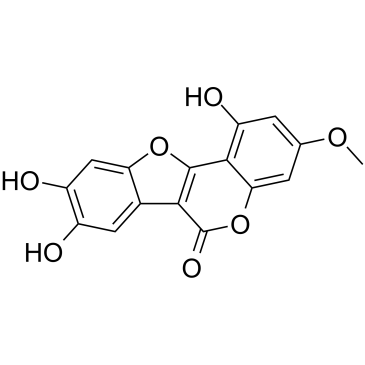wedelolactone

wedelolactone structure
|
Common Name | wedelolactone | ||
|---|---|---|---|---|
| CAS Number | 524-12-9 | Molecular Weight | 314.246 | |
| Density | 1.7±0.1 g/cm3 | Boiling Point | 498.4±45.0 °C at 760 mmHg | |
| Molecular Formula | C16H10O7 | Melting Point | 315 °C | |
| MSDS | Chinese USA | Flash Point | 255.2±28.7 °C | |
| Symbol |

GHS07 |
Signal Word | Warning | |
|
Understanding the mechanisms controlling Leishmania amazonensis infection in vitro: the role of LTB4 derived from human neutrophils.
J. Infect. Dis. 210(4) , 656-66, (2014) Neutrophils are rapidly recruited to the site of Leishmania infection and play an active role in capturing and killing parasites. They are the main source of leukotriene B4 (LTB4), a potent proinflammatory lipid mediator. However, the role of LTB4 in neutroph... |
|
|
CYLD is a crucial negative regulator of innate immune response in Escherichia coli pneumonia.
Cell. Microbiol. 10(11) , 2247-56, (2008) Bacteraemic pneumonia is a common cause of sepsis in critically ill patients today and is characterized by dysregulation of inflammation. The genetic factors predisposing to bacteraemic pneumonia are not yet fully understood. Innate immunity is pivotal for ho... |
|
|
Demethylwedelolactone derivatives inhibit invasive growth in vitro and lung metastasis of MDA-MB-231 breast cancer cells in nude mice.
Eur. J. Med. Chem. 56 , 361-7, (2012) The anticancer properties of demethylwedelolactone (DWEL) and wedelolactone (WEL), which are naturally occurring coumestans, have not been well characterized. In this study, we investigated the anti-invasive effects of synthetic WEL and DWEL on human MDA-MB-2... |
|
|
Wedelolactone, a medicinal plant-derived coumestan, induces caspase-dependent apoptosis in prostate cancer cells via downregulation of PKCε without inhibiting Akt.
Int. J. Oncol. 41(6) , 2191-9, (2012) Emerging studies indicate that metabolism of arachidonic acid through the 5-lipoxygenase (5-Lox) pathway plays a critical role in the survival of prostate cancer cells raising the possibility that 5-Lox can be targeted for an effective therapy of prostate can... |
|
|
Anti-inflammatory gallic Acid and wedelolactone are G protein-coupled receptor-35 agonists.
Pharmacology 89(3-4) , 211-9, (2012) G protein-coupled receptor-35 (GPR35) has been shown to be a target of the asthma drugs cromolyn disodium and nedocromil sodium. Gallic acid and caffeic acids are reported to modulate allergic reactions via unknown mode(s) of action. Here we attempt to elucid... |
|
|
High glucose-induced IKK-Hsp-90 interaction contributes to endothelial dysfunction.
Am. J. Physiol. Cell Physiol. 296(1) , C182-92, (2009) A decline in the bioavailability of nitric oxide (NO) that causes endothelial dysfunction is a hallmark of diabetes. The availability of NO to the vasculature is regulated by endothelial nitric oxide synthase (eNOS) activity and the involvement of heat shock ... |
|
|
Tumour necrosis factor alpha down-regulates the expression of peroxisome proliferator activated receptor alpha (PPARα) in human hepatocarcinoma HepG2 cells by activation of NF-κB pathway.
Cytokine 61(1) , 266-74, (2013) Peroxisome proliferator activated receptor-alpha (PPARα) plays a major role in the regulation of lipid and glucose homeostasis, and inflammatory responses. The objectives of the study were to systematically investigate the effects of TNF-α and its regulatory ... |
|
|
Redox state alters anti-cancer effects of wedelolactone.
Environ. Mol. Mutagen. 53(7) , 515-24, (2012) Wedelolactone is one of the active plant polyphenolic compounds. Anti-tumor effects of this drug have been demonstrated recently. We have described that wedelolactone acts as catalytic inhibitor of DNA topoisomerase IIα. The aim of this study was to further c... |
|
|
Simultaneous inhibition of the constitutively activated nuclear factor kappaB and of the interleukin-6 pathways is necessary and sufficient to completely overcome apoptosis resistance of human U266 myeloma cells.
Cell Cycle 7(20) , 3235-45, (2008) Elevated Nuclear Factor kappaB (NFkappaB) levels have been reported in multiple myeloma cells derived from patients relapsing after chemotherapy. In the search of an in vitro a model with molecular features similar to relapsing lesions, we focused our attenti... |
|
|
Apoptosis is induced in Chlamydia trachomatis-infected HEp-2 cells by the addition of a combination innate immune activation compounds and the inhibitor wedelolactone.
Am. J. Reprod. Immunol. 65(5) , 460-5, (2011) Innate immune activation of human cells, for some intracellular pathogens, is advantageous for vacuole morphology and pathogenic viability. It is unknown whether innate immune activation is advantageous to Chlamydia trachomatis viability.Innate immune activat... |